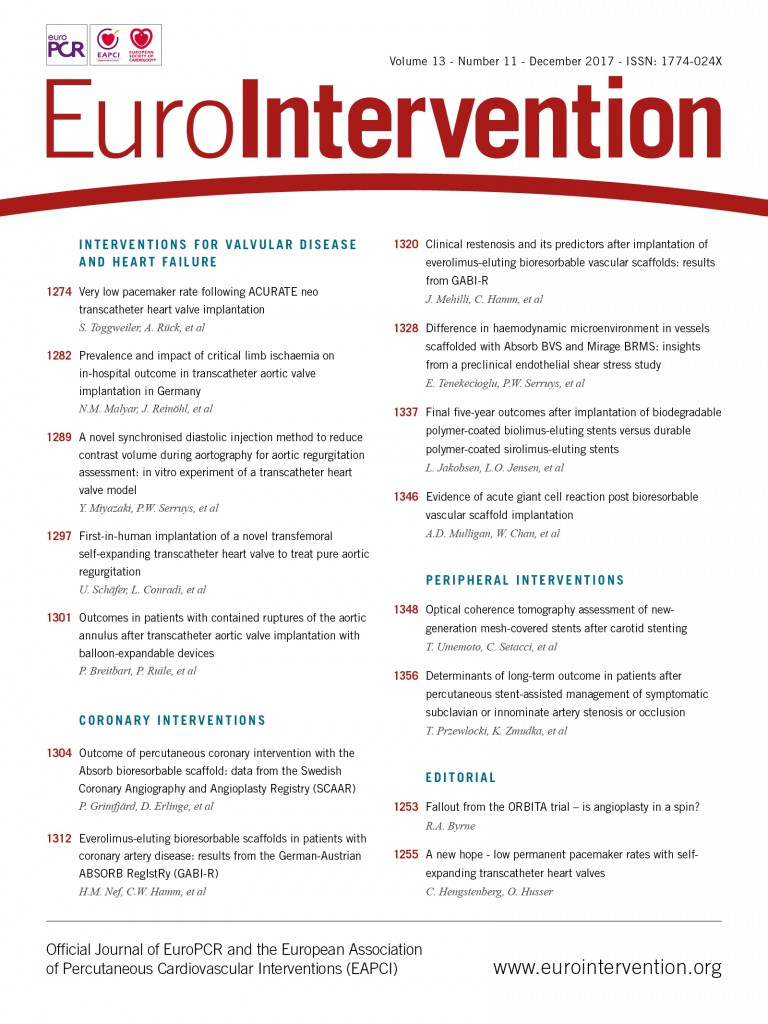
We read with much interest the recent paper by Kawashima et al1, assessing the outcomes of the percutaneous approach vs. surgical cut-down for transfemoral transcatheter aortic valve implantation (TF-TAVI) in a propensity-matched population from the Optimized CathEter vAlvular iNtervention (OCEAN)-TAVI registry. In the matched analysis of 166 pairs they found a lesser frequency of major vascular complications (15.1% vs. 27.1%, p<0.01), major bleeding (7.2% vs. 16.9%, p=0.01) and less need for blood transfusion (21.1% vs. 38.0%, p<0.01) in the percutaneous group when compared with the cut-down group. This advantage was also reflected in a lesser frequency of acute kidney injury (6.0% vs. 15.1%, p<0.01). Furthermore, they found shorter procedural times, ICU stay and in-hospital stay in the percutaneous arm.
These results are of great value as, to our knowledge, there is only one single-centre randomised study with a small number of patients (n=30) and with balloon-expandable prostheses that has described a similar rate of vascular complications between both options, suggesting the feasibility and safety of the completely percutaneous approach2. We have also recently published the Spanish experience from 2010 to 2015 in 2,546 patients who underwent TF-TAVI, with the percutaneous access accounting for 74.3%. In fact, this is the largest study in the literature comparing puncture vs. surgical cut-down, including both balloon-expandable and self-expanding prostheses3. We performed a propensity-matched analysis resulting in 615 pairs3. At 30-day follow-up, the percutaneous approach yielded a higher rate of minor vascular complications: most of them were access-site-related, such as stenosis/dissection or stenting in the femoral artery (89 [15%] vs. 25 [4.1%]; RR 3.56, 95% CI: 2.32-5.47, p<0.001). Similarly to the results provided in the present paper, we reported higher rates of major bleeding in the cut-down group (21 [3.4%] vs. 9 [1.5%]; RR 0.43, 95% CI: 0.20-0.93, p=0.03)3. This complication rate remained significantly different and favourable to the percutaneous group at 323-day follow-up.
Remarkably, the fast development of the technology and the growing experience of the TAVI teams in the USA and Europe have brought about the simplification of the access technique, evolving from a surgical to a percutaneous approach. No randomised data supported this evolution but data from observational studies and now these two propensity-matched analyses seem to confirm the superiority of the truly percutaneous approach over surgical cut-down. Even though there might be a learning curve related to this step, we broadly recommend to our Asian colleagues and centres still performing surgical cut-down to move to the percutaneous approach if the vascular anatomy is suitable. Preprocedural evaluation of the iliofemoral anatomy and teams trained to solve any vascular injuries remain essential to achieve this objective.
Conflict of interest statement
The authors have no conflicts of interest to declare.

